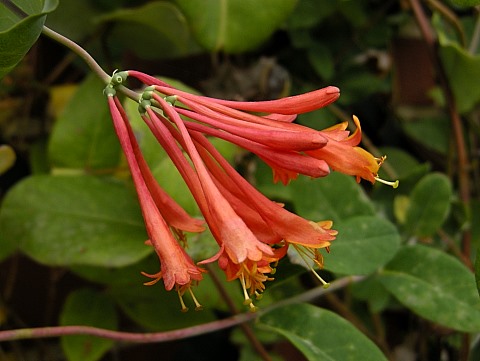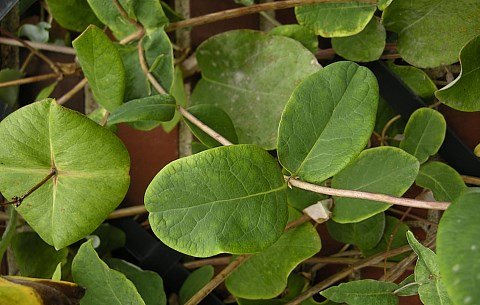Description: This perennial vine is semi-woody and up to 18' long, branching occasionally. It is able to climb up walls, fences, and adjacent vegetation by its twining or draping stems. In more southern areas, where this vine is native, it becomes a fully woody vine with evergreen leaves. The bark of this vine is yellowish brown and shreds into thin strips. In more northern areas of the Midwest and Northeast, the leaves are deciduous and the stems die down to the ground during the winter. Young stems are terete and usually hairless; they are initially light green or reddish green, but later become pale brown.

At intervals along
the stems, they are pairs of opposite leaves up to 3" long and 2"
across. The leaves have a rather thick leathery texture. The upper
surfaces of the leaves are yellowish green to dark green, smooth, and
glossy, while their lower surfaces are pale green, glaucous, and
usually hairless. The leaves are usually oval in shape with smooth
margins; their petioles are short or absent. Where the vine branches
into two stems, the underlying opposite leaves merge together, becoming
perfoliate-connate. This also happens whenever a stem terminates in an
inflorescence: the underlying opposite leaves merge together, forming a
circular-square shape around the stem. Each inflorescence consists of
several whorls of 3-6 flowers. These successive whorls of flowers are
separated from each other by only short distances. Each flower is 1½–2"
long, consisting of a long corolla with a slender funnelform shape and
a small calyx at its base. The corolla is bright orange-red on the
outside, and yellow in its interior; it has 5 lobes along its outer rim
that are short and rounded. Each flower has 5 stamens and a single
style with a globoid stigma; these reproductive organs are slightly
exerted from
the corolla. The small calyx is light green and hairless; it has 5 tiny
teeth along its outer rim. In Illinois, Trumpet Honeysuckle blooms
during the summer and fall for 2-4 months, although in the southeastern
United States, it also blooms during the spring. Each fertile flower is
replaced by a single ovoid fruit about 3/8" (10 mm.) across. Each fruit
becomes
bright red when it is ripe and contains a single seed. This perennial
vine reproduces by reseeding itself.
Cultivation:
Trumpet Honeysuckle readily adapts to partial sunlight, mesic
conditions, and loamy or rocky soil. The leaves may turn prematurely
yellow and fall off the stems during very dry weather, or they may
become infected with powdery mildew during the cooler fall if good air
circulation is absent.
Range &
Distribution: In Illinois, Trumpet Honeysuckle
occasionally naturalizes in the southern half of the state, while it is
less common in the northern half. These escaped populations may or may
not persist; Trumpet Honeysuckle is not particularly invasive. Typical
habitats include roadsides, fence rows, and thickets; it is less common
in natural areas containing savannas and rocky open woodlands. Because
of the beautiful flowers and attractive foliage, Trumpet Honeysuckle is
often cultivated as an ornamental plant. This vine is native to
southeastern United States, but not Illinois.
Faunal Associations:
The flowers are cross-pollinated by the Ruby-Throated Hummingbird; they
provide nectar to this visitor. The caterpillars of two interesting
moths, Hemaris thysbe (Hummingbird Clearwing) and Hemaris
diffinis (Snowberry Clearwing), feed on the foliage of
honeysuckles (Lonicera spp.). Other insects that
feed on honeysuckles
include Hyadaphis foeniculi (Honeysuckle Aphid), Zaraea
inflatus (Honeysuckle Sawfly), and the moth Callizia
amorata (Gray Scoopwing). The caterpillars of the Gray
Scoopwing feed gregariously within the safety of webs covering the
foliage. The berries of Trumpet Honeysuckle are occasionally eaten by
some songbirds, while White-tailed Deer browse on the foliage and stems.
Photographic Location:
Along a brick building in downtown Champaign, Illinois.

Comments: Because Trumpet Honeysuckle isn't native to Illinois, I have placed it in the Weedy Wildflowers section of this website, but this is a very attractive vine to cultivate. The flowers are lovely and bloom over a long period of time. If the woody vine, Campsis radicans (Trumpet Creeper), is too large and aggressive to cultivate in your yard, a more mild-mannered and refined alternative is Trumpet Honeysuckle. There are other honeysuckle vines in Illinois (many of them are native), but they have white or cream-colored flowers. The pale flowers of these honeysuckles attract a greater range of pollinators: typically Sphinx moths, butterflies, and hummingbirds.